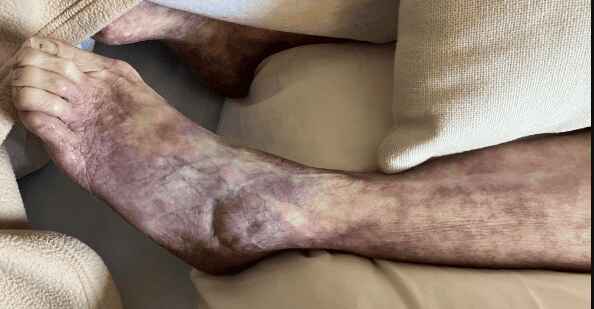Mottling of Skin Near Death
Published on October 18, 2023
Updated on July 13, 2024
Published on October 18, 2023
Updated on July 13, 2024

Table of Contents
As a caregiver or family member, it can be challenging to witness the changes that occur as a loved one approaches the end of their life. One such change may be mottled skin, also known as livedo reticularis. Understanding mottled skin and its significance in the dying process can help you provide the best care and support to your loved one during this time.
Mottled skin refers to the appearance of a patchy, discolored pattern on the skin. It may resemble a net-like or lace-like pattern and can vary in color, ranging from reddish blue to purple or brown. Mottled skin is caused by reduced blood flow to the skin’s surface, leading to changes in its appearance.
Mottled skin occurs when the body’s circulation slows down as a natural part of the dying process. As a person approaches the end of their life, their heart may become less effective in pumping blood, resulting in reduced blood flow to the skin. This decreased circulation can cause the skin to appear mottled or discolored.
Identifying mottled skin can be an important indicator of the imminence of death. Here are some signs to look out for:
Mottled skin is common in the last days or hours before death. While it can be distressing to witness, it is a meaningful clinical sign that the body is transitioning towards the end-of-life stage. Mottling indicates that the body’s systems, including circulation, slow down as the person approaches their final moments.
Understanding that every individual’s end-of-life journey is unique is essential, and not everyone will experience mottled skin. However, if you do observe mottling in your loved one, it can be a sign that death may be imminent. During this time, providing comfort, support, and a peaceful environment for your loved one is crucial.
As a caregiver or family member, there are several ways you can provide comfort and support to your loved one with mottled skin:
Remember, your presence, love, and support are crucial. Offer emotional support, hold their hand, and engage in comforting conversations or activities based on their preferences.
Recognizing mottled skin and its significance in dying can help you provide compassionate care to your loved one. While mottled skin indicates a decline in circulation and may indicate imminent death, every person’s end-of-life journey is unique. Focus on providing comfort, maintaining a peaceful environment, and offering emotional support to your loved one during this time.
Mottled Skin Before Death: What You Should Know
Between Life and Death: A Gospel-Centered Guide to End-of-Life Medical Care
Providing Comfort During the Last Days of Life with Barbara Karnes RN (YouTube Video)
Preparing the patient, family, and caregivers for a “Good Death.”
Velocity of Changes in Condition as an Indicator of Approaching Death (often helpful to answer how soon? or when?)
The Dying Process and the End of Life
Gone from My Sight: The Dying Experience
The Eleventh Hour: A Caring Guideline for the Hours to Minutes Before Death